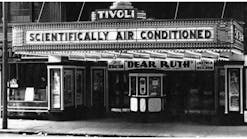Soon after moving into a former Apollo moon-mission training facility in Warminster, Pa., Transcontinental Direct, the recently established U.S. subsidiary of Canadian printing firm Transcontinental Inc., discovered that production capacity was increasing much faster than cooling equipment could be installed and that only about a quarter of the 340,000-sq-ft plant was being cooled adequately. This became a particularly serious issue when a summer heat wave caused the plant floor to experience temperatures in excess of 100°F.
OPTIONS
Transcontinental Direct considered replacing the chiller plant, which was past its useful life. This would require removal of existing equipment, renovation of the mechanical room to make it large enough to house a new system, and installation of new equipment. Because Transcontinental Direct leased the printing plant and, thus, did not own the equipment room, permission to renovate would need to be obtained. This made replacing the chiller plant a costly and time-consuming option.
Transcontinental Direct also considered installing a packaged rooftop-unit system. However, without significant fortification, the building's roof would not support the weight of the several units needed to provide adequate air conditioning. Also, the building's landlord was opposed to cutting openings in the 3-ft-thick concrete roof for installation of such a system. Lastly, Transcontinental Direct recognized that if it chose not to renew its lease, it would have to remove the rooftop units and restore the roof to its prior condition or leave behind the equipment and take a loss on any remaining value.
Transcontinental Direct realized that neither renovation of the chiller plant nor installation of packaged rooftop units was a desirable course of action. While they may have led to adequate cooling, those options did not offer what the company needed: a solution that provided flexibility and minimized building impact without being prohibitively expensive.
SOLUTION
Recognizing that a different type of solution was called for, Ecogenia, a Montreal-based distributor of HVAC products and controls, specified two 335-ton LL Series chillers from AAON Inc. The LL Series integrates mechanical-room components into a single packaged outdoor unit that includes a heat exchanger, a pumping package, boilers, expansion tanks, controls, and an air-cooled or a high-efficiency evaporatively cooled condenser section. A cooling tower is not required.
For indoor air distribution, 14 modular indoor air handlers from AAON, including six with electric heat to supplement the building's existing gas heat system, were specified. These units are easily configurable and completely factory-wired, featuring foam-panel composite construction with a thermal break for high thermal efficiency, direct-drive plenum fans with optional premium-efficiency motors, and optional variable-frequency drives for quiet, energy-efficient operation. Units may be shipped completely factory-assembled or in sections.
The indoor air handlers arrived fully assembled and were suspension-mounted from the ceiling without interrupting business (24/7 operation).
The AAON units provide much-needed flexibility. The chillers were placed at ground level in an unused area at the rear of the building; if necessary, they could be relocated easily. The air handlers, meanwhile, were joined with fabric ductwork that can be removed easily for washing.
By minimizing installation requirements, avoiding the need for a chiller-restoration service contract or the costs associated with placing rooftop units, and purchasing completely factory-assembled, wired, and tested equipment, Transcontinental Direct was able to control labor costs. The initial estimated cost of restoring the central chiller plant was $3.6 million; the packaged-outdoor-chiller solution was completed for $1.8 million.
According to Marc Lacombe, director of procurement and real estate for Transcontinental, the AAON system was “the most cost-effective, both from an initial capital expenditure and from an ongoing operational point of view.” The end result of the project pleased everyone involved. The landlord was satisfied that no serious building alterations were needed. Ecogenia signed an agreement with Transcontinental to provide environmental solutions for future projects throughout North America. And, perhaps most importantly, the system was installed before the start of the cooling season.
Information and photographs courtesy of AAON Inc.
Circle 149








